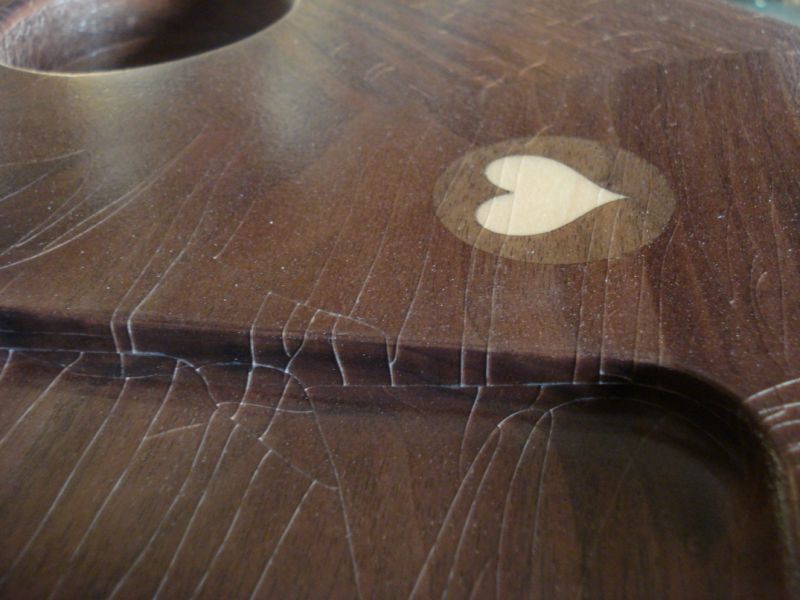Question
I have been using pre-cat lacquer for about 4 years and this is the first time I have had this finish crack. The cracking did not show up until about 3 days after I applied the last of 4 coats. A little history... The tables are solid kiln dried walnut (except the inlays). I don't use a sanding sealer. The finish is thinned with 2 oz. of lacquer thinner per 30 oz. of finish. Sanded between coats. The last coat I add a little fish eye eliminator. (One cap full per 30 oz.) I spray with HVLP. I keep the finishing room at 70 degrees all the time.
The finished tables are stored in the same room that they are finished in. 24 hours after the last coat I cover them with a clean drop cloth and store until assembly.
After I took a few pictures and cussed a lot, I did a tape test in several spots and did not have any of it pull loose, but I am not sure if I did the test correctly. Then I started sanding off the finish and it looks as if the cracking is all the way through the finish.

Forum Responses
(Finishing Forum)
From contributor G:
Four coats? Is that your usual schedule? What is the recommended mil build for your pre-cat?
Was the wood acclimated to the room where it was finished? Any chance sitting in a nice warm room for a few days caused the wood to have a significant change in moisture content (e.g., shrink or swell)? That could cause the cracking.
Then there's the thickness limit of catalyzed finishes. It's pretty standard for catalyzed finishes to have a limit of 4 dry mils. More than that and they're prone to cracking. Some crack more easily than others. The more you go over the dry mil limit, the more likely the finish is to crack. In the long run, thicker finishes always crack even when applied according to directions. Thinner finishes are less prone to cracking in the short and long term.
I can see from your picture the finish is thick. The cracks go right around a sharp corner...! Next time you order some lacquer, ask your supplier for a wet mil gauge ($2 - $3 if it's not free). Then take a look at the article at the link below and find out how thick you're applying your finishes. If you know how thick the finish is when you spray it, you can figure out how thick it is when it dries. For example, if your finish has 25% solids and you spray a 4 mil wet coat, you'll end up with a 1 mil dry coat. That's because 75% of it (3 mils) is solvents, not solids, and will evaporate. Generally speaking, 3 coats at 3-4 mils each is as much finish as you want to apply (with sanding between coats).
I'd also recommend you stop using the Smoothie unless you have to use it in every coat to avoid craters. No point in changing the surface tension and internal stresses of the final coat of finish.
I will get a mil gauge (already ordered) and use it.
One side note... I have had problems with orange peel and think I might be a little heavy handed with the spray.
I have a moisture meter and use it often. This walnut checks out fine.
To all - I think I got lucky twice... In the past because I have not had this problem before. And yesterday when I asked for your help. Thank you.
You could thin it even more if needed, but the more thinner you add the easier it is to get runs and sags and you'll get less build with each coat of finish (which may not be such a bad thing when you want to avoid applying the finish too thick).
When you strip the table, do not use a water wash even if the directions call for it. Instead, wash the residue off with lacquer thinner or acetone. Water can cause all sorts of problems with veneer and inlays and raises the grain of the wood.
But you can adjust the dry to touch time with lacquer thinners that are blended to either slow or speed up the drying time. You may be able to get lacquer thinners labeled "slow," "medium," and "fast" from your supplier. All that means is the slow lacquer thinner will evaporate more slowly and it's a good choice when the temperature is hot and the humidity is up. Slow thinner is often called "retarder."
Medium is for most occassions... temperature and humidity are moderate. The fast is for cooler days (not below the recommended minimum application and curing temperature). A common practice is to use medium reducer all the time and add some slower evaporating thinner to it when it's hot and/or humid. MAK is a good retarder and you only need to replace 2-3% of the regular thinner with it. For example, if you use 5 ounces of thinner per quart but want to add retarder to avoid blushing, solvent pop, or other related spray defects, add 1/2 - 1 ounce of MAK to 4 ounces of your regular thinner. You can use a higher percentage of retarder if you want or need to. If you add a lot, it will take the surface of the finish a long time (e.g., hours) to be dry to the touch.
To speed up the dry time in cooler weather, you'll want to use a fast thinner. Acetone works well for this.